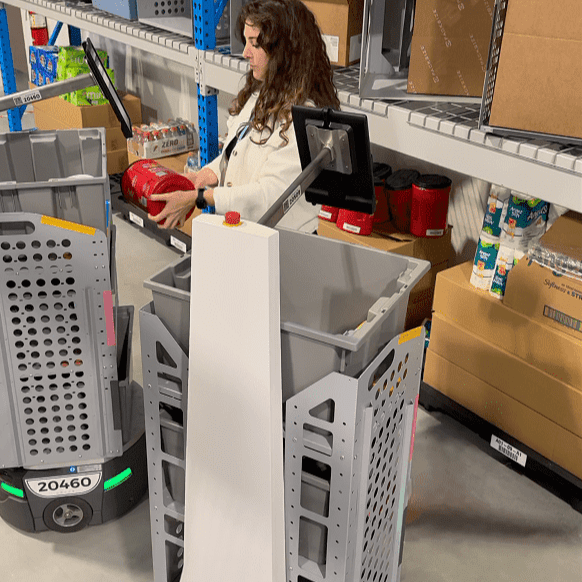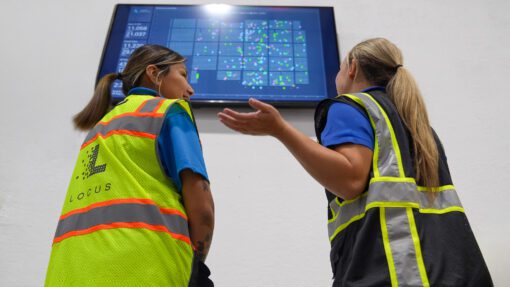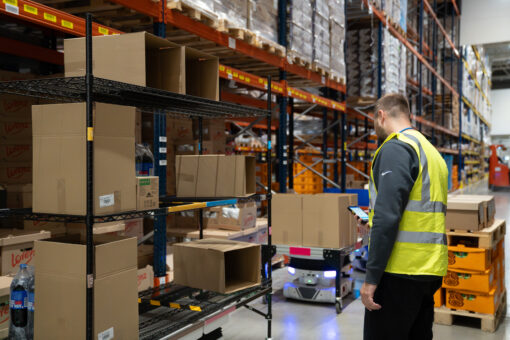WP: How to achieve 400 UPH with Locus Fast Pick
WP: How to achieve 400 UPH with Locus Fast Pick Download Now!
The Warehouse Automation Glossary: Terms Every Warehouse Exec Should Know
Mary Hart, Sr. Content Marketing Manager

From autonomous robots to UPH, the language of warehouse automation is changing as fast as the technology itself. Whether you’re optimizing for peak season or just starting to explore robotics, clear definitions matter, especially when you’re evaluating vendors, setting KPIs, or aligning operations across teams.
This warehouse automation glossary breaks down the essential terms warehouse managers and executives use every day. Bookmark it, share it with your team, and refer back often as your operation scales.
Warehouse Automation Methods and Picking Models
Person-to-Goods (P2G):
A warehouse model where autonomous robots take goods from the person doing the picking or putaway of returns to reduce unnecessary walking and boost productivity. With the P2G model, the inventory remains in one location and does not move.
Goods-to-Person (G2P):
A fulfillment approach where conveyors, shuttle systems, and the like move inventory/goods to the person doing the picking or packing. G2P can require infrastructure changes and doesn’t allow for the flexibility or scalability of P2G. With G2P, there are additional safety requirements and/or cordoned off areas in the warehouse that are made inaccessible to people.
Robots-to-Goods (R2G):
A next-generation automation model where mobile robots travel autonomously to the goods, perform the pick, and move the order forward without human intervention. R2G enables scalable, flexible fulfillment without fixed infrastructure, and is ideal for dynamic warehouse environments. With the R2G model, the inventory is stationary and always available, either by robot or human, if necessary.
Key Warehouse Metrics and Performance Indicators
Units Per Hour (UPH):
A standard productivity metric that tracks how many units an associate or system can pick, pack, or process in one hour. Often used to benchmark performance before and after automation.
Lines Per Hour (LPH):
The number of order lines fulfilled per hour. Each line may represent a unique SKU or item type in an order.
Mission Time:
The total time it takes to complete a Locus Robot to complete a mission from order release to fulfillment. Reducing mission time is a common goal of warehouse automation.
Putaway Mission Time:
The time it takes for received goods to be put away available for picking. Efficient receiving and putaway processes, often supported by autonomous robots, can shorten this window.
Throughput:
The total volume of goods moved through a facility in a given time by tracking Units and LInes. Increasing throughput without adding labor is one of the primary goals of warehouse automation.
Warehouse Automation Technology and Infrastructure Terms
AMR (Autonomous Mobile Robot):
Self-navigating robots that transport goods within a warehouse without fixed paths. AMRs, also known as autonomous robots, can adapt to real-time changes in layout or workflow.
WMS (Warehouse Management System):
Software that orchestrates warehouse operations, including inventory management, order processing, and labor allocation. A strong WMS integrates well with robotics platforms.
API (Application Programming Interface):
A set of protocols enabling communication between software systems that is essential for connecting robotics platforms with existing WMS or ERP tools.
System-Directed Labor:
A method where software assigns tasks to workers or robots based on priority, proximity, and workload data. Helps optimize workflows and reduce decision-making lag.
Warehouse Operations and Layout
Zone Picking:
An order fulfillment strategy where the warehouse is divided into zones, and workers (or robots) pick items only within their designated areas.
Batch Picking:
A method where multiple orders are picked simultaneously to maximize efficiency. Often paired with automation to minimize redundant travel.
Putaway:
The process of moving received inventory from receiving docks to storage locations. Optimized putaway is critical to ensuring fast, accurate picking later.
Slotting:
The strategic placement of inventory within a warehouse to optimize travel time and picking efficiency. Frequently re-evaluated in high-SKU or seasonal environments.
Travel Time:
The amount of time workers or robots spend moving between tasks or locations. A key warehouse efficiency metric that automation is designed to reduce.
Supporting Concepts
Robots-as-a-Service (RaaS):
A flexible automation model where companies subscribe to robotic systems on a monthly or usage-based basis. This enables operational expenditure versus capital expense; minimizes upfront investment; and enables easier scaling.
Digital Twin:
A virtual representation of a physical warehouse or workflow that can be used to simulate improvements or test automation strategies before physical deployment.
Exception Handling:
The process of managing non-standard or error-prone tasks like damaged items or out-of-stock SKUs. Automation platforms are increasingly supporting these with AI and real-time alerts.
Why These Warehouse Automation Terms Matter
As warehouse automation becomes more central to supply chain performance, having a shared language across teams, vendors, and systems is foundational. Whether you’re implementing autonomous robots, evaluating your UPH targets, or redesigning workflows, this glossary can help ground your decisions in clarity and shared understanding.
At Locus Robotics, we help fulfillment centers embrace models like Person-to-Goods (P2G), Robots-to-Goods (R2G), and System-Directed Labor to achieve unmatched flexibility and unlimited throughput without locking you into rigid infrastructure. If you're ready to simplify the complex, we're ready to talk.




